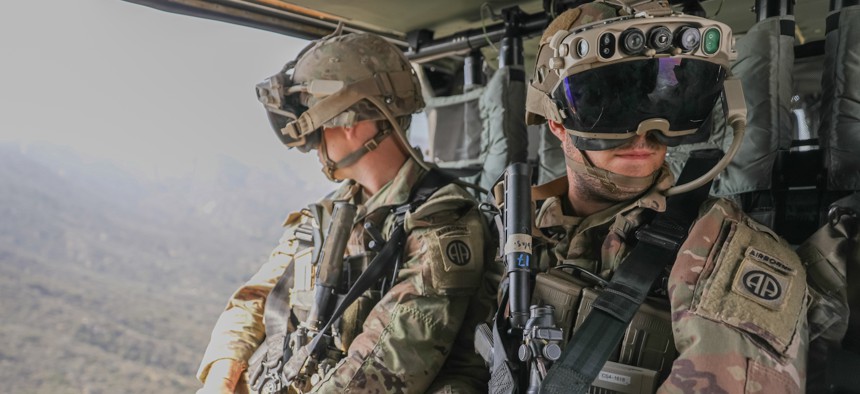
U.S. Army Sgt. Jared Row and Spc. Jordan Deblasi, assigned to 82nd Airborne 3rd Brigade Combat Team, observe area of operations during Project Convergence (PC22) at Camp Talega on Camp Pendleton, California on Oct. 12, 2022. U.S. Army / Spc. Lessitte Canales
The Military’s Network Warfare Experiment Scaled Up This Year
The U.S. Army-led experiment attempted to create a lot more targets, challenges, and complexities to test out futuristic concepts.
Project Convergence 2022, the third iteration of the military’s massive networked warfare experiment, saw autonomous helicopters and futuristic augmented headgear, but the real focus was enlarging the experiment to better replicate a major conflict and include forces from other services and allies.
Speaking to reporters from Camp Pendleton, California, officials from the U.S. Army and other services discussed one portion of the multi-day event, the successful conclusion of the first wargame scenario of three incorporating elements of maritime warfare. Officials emphasized that while Project Convergence began as an Army effort, it now features representatives from across the services, and allies such as the United Kingdom and Australia. This year’s event linked components across much larger distances, from Camp Pendleton to Hawaii to Australian forces in Australia.
The experiment featured an autonomous Black Hawk delivering more than 3,000 lbs of cargo in support of conventional and special operations forces. That demonstration caps eight-plus years of development and experimentation by DARPA, the Army, and Black Hawk-maker Sikorsky to fly a fully autonomous Black Hawk in an actual exercise. Army Chief of Staff Gen. James McConville emphasized that artificial intelligence was used not only for autonomous flight, but also for predicting maintenance and resupply of troops.
“Logistics,” McConville said, is “something some people don't spend a lot of time on. But we think we will be contested, and if we take a look at other conflicts, logistics are absolutely critical.”
The experiment also featured special operations forces using the IVAS heads-down display to receive up-to-the-moment intelligence, including from allied militaries, said Lt. Gen. Scott McKean, deputy commanding general of the U.S. Army Futures Command: “What we demonstrated out here was the ability to pass data to the tactical edge, that soldier who's is far forward from our other services, and in this case, even Australia was able to pass some very relevant data to our soldiers using IVAS.”
The “Scenario A” demonstration also incorporated long-range fires from across the services, like Navy Tomahawks and SM-6 missiles, as well as the Army’s Long Range Hypersonic Weapon, or LRHW, which features a 1,000-kilometer range.
But the most important technology elements were the variety of integrated targeting and networking components, including artificial intelligence programs such as Synchronized High Optempo Targeting, which “applies sensor data to target-selection standards, the attack guidance matrix and … fires support fundamentals, using AI and autonomous capabilities to pick the best targets to hit.”
Testing the different fires solutions, as well as the links between sensors and shooters, at a much larger scale was a key part of this year’s event, McConville said.
“The scale of of the missions we took on this year are much greater,” he said. “By way of example, it might be an attack of many, many missiles, rather than just one missile against one target using … sensors from … another service. There'll be many missiles in a highly complex environment and that allows us really … to stress the system and get the results that we need to see to make sure we can do that in a real-world environment.”




